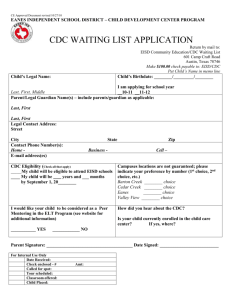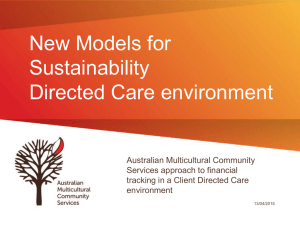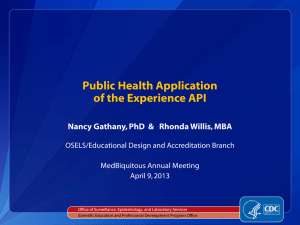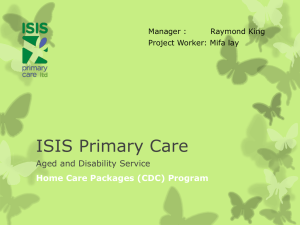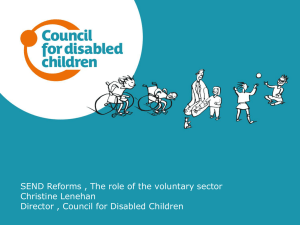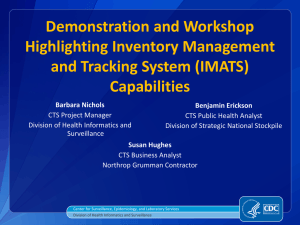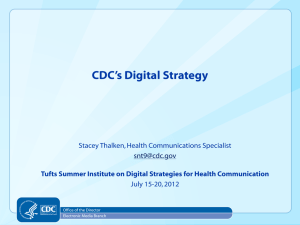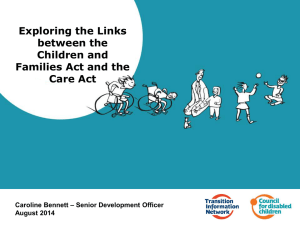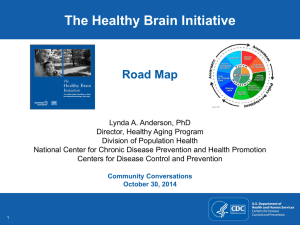Adapting to Consumer Directed Care funding
advertisement
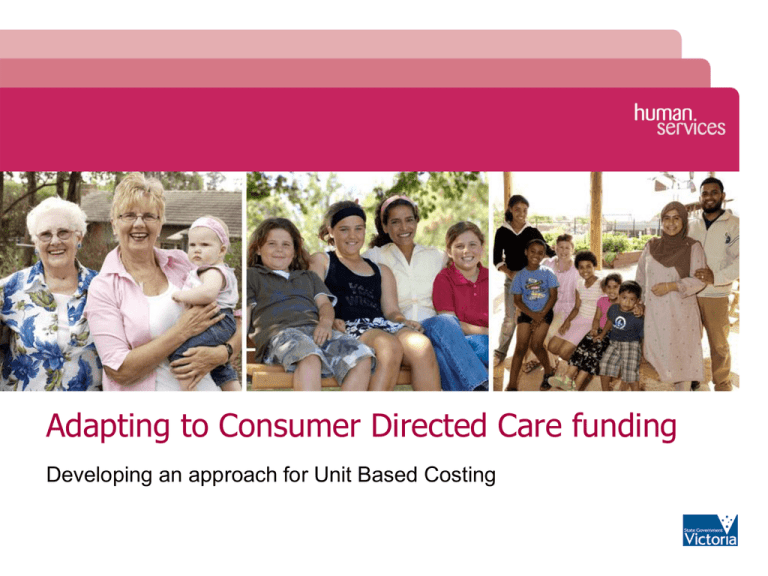
Adapting to Consumer Directed Care funding Developing an approach for Unit Based Costing Australian Multicultural Community Services (AMCS) • Are a not-for-profit charitable organisation that supports individuals from culturally and linguistically diverse backgrounds • Have an emphasis on providing community aged care • Work closely with other multicultural organisations and initiate capacity building projects in the rapidly changing funding and service environment About Consumer Directed Care • In July 2010 the Australian Government commenced Consumer Directed Care (CDC) across all Australian Government funded Packaged Care Programs • CDC allows people to have greater control over their own lives by allowing them, to the extent that they are capable and wish to do so, to make choices about: • ▪ the types of care services they access ▪ the delivery of those services ▪ who will deliver the services and ▪ when they are delivered The CDC model delivered in packaged care is an individual budget based on a needs assessment and administered on the care recipients behalf, by an approved provider, for an agreed percentage of the allocated budget Impact of Consumer Directed Care • The introduction of CDC will require community aged care providers to modify the way in which they deliver services • This will include a greater level of accounting requirements through the collating of information for monthly statements detailing the cost of care and funding received by clients • This new government funding model presents significant challenges for NFPs to ensure financial viability Building community sector capacity to adapt to a new funding environment • A review of AMCS’s readiness to operate under a CDC model was undertaken in partnership with GreatConnections, a program of Leadership Victoria • GreatConnections links experienced professional volunteers with the needs of NFPs in areas of business planning and change management • A skilled volunteer assisted AMCS to assess their organisational systems and processes and build their capacity to develop and implement a unitbased costing model • AMCS developed a trial based on the assessment results and developed a tool to assist other NFP organisations to adapt to a CDC environment Developing a costing model • Following a project trial and analysis, and consultation with other aged care organisations, AMCS established a CDC financial approach • The core components of the approach are: ▪ A costing model that outlines how to allocate expenses to programs, using either a ‘labour’ rate or an ‘overhead’ rate ▪ A comprehensive tool available in Excel format to assist providers determine these rates ▪ A training program developed to assist service providers transition to CDC. It covers: ▫ understanding the real cost of delivering care, ▫ calculating appropriate labour rates, overhead rates and margins How expenses are allocated in the new costing model • Expenses are allocated to programs in two methods, either directly or by recording centrally • Directly includes the cost of care and wages (plus on-costs) incurred and an hourly rate calculated for care workers and case managers • Recording centrally costs are allocated based on the resources intensity of the program; includes direct labour, administration and general overheads • An appropriate margin to ensure sustainability can be included in a direct hourly labour rate or separated out on the client’s budget Key learning: how to adjust to CDC model • Community sector organisations impacted by the introduction of CDC can build internal capacity to adjust to the new policy and funding model by ensuring: ▪ financial recording systems are in place ▪ relevant staff understand the overall costs of providing home care ▪ regular reviews and evaluation of care levels are undertaken ▪ increased attention to and awareness of costing activities ▪ staff are supported and guided in their transition to CDC Conclusion • To ensure financial sustainability for NFP community service organisations, the Building Community Sector Capacity to Adapt to a New Funding Environment project has identified the systems and cultural changes required for the future • The project outcome is a CDC tool and training program developed to assist organisations to become CDC-ready • This resource is now available for use by other community organisations by through AMCS • The project has also highlighted the benefits of partnership with other NFP organisations, such as Leadership Victoria, to access expertise which may not be available ‘in house’ Further information • Further information on the CDC tool and training program developed through this project can be obtained by contacting Australian Multicultural Community Services: Tel: 03 9689 9170 Email: info@amcservices.org.au Website: www.amcservices.org.au • Details about CDC and guidelines are available from the Department of Health and Ageing website: http://www.health.gov.au/internet/main/publishing.nsf/Content/ageing-cdcops-manual.htm

